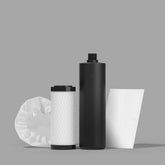NSF/ANSI Ultra Violet Standards
Current NSF/ANSI UV System Standards
The following is a review of an Article written and prepared by Rick Andrew, NSF Director of Global Business Development. The article provides an overview of the current NSF/ANSI UV system standard.
We hope this information provides you with a better insight as to what standards NSF/ANSI uses to evaluate Ultraviolet purification systems.
NSF/ANSI 50 is the standard that covers materials, components, products, equipment and systems related to public and residential recreational water-facility operations. This standard includes a broad range of requirements for UV systems used as supplemental treatment for recreational water with primary disinfection. This range includes requirements for safety of materials, clean-ability, design pressure, flow control, performance indication, user’s instructions, operational protection, life testing, hydrostatic pressure resistance and supplemental disinfection and performance.
There are requirements for systems with claims of Cryptosporidium inactivation applicable only to those systems with such claims. These systems must demonstrate supplemental disinfection performance through 3-log reduction of bacteria when tested according to the method specified by the standard E. faecium and P. aeruginosa and used for this testing. The systems are installed on a test apparatus containing a volume of water such that a minimum of five cycles of water through the UV system in 30 minutes is achieved when operating. The UV system and test apparatus are operated and samples are collected after each system cycle until the required cycles have been completed. After each, cycle a minimum of 3 –log reduction must be achieved as demonstrated by analysis of the collected samples.
NSF/ANSI 50 includes requirements for those UV systems that are intended to inactivate Cryptosporidium in a recreational water application. These systems must achieve 3–log reduction in a single pass of treatment.
NSF/ANSI 55 is the standard that covers UV water treatment systems and components for point of use and point of entry applications. It addresses the safety of materials in contact with drinking water through extraction testing and toxicological assessment of extraction testing results. This standard includes requirements for structural integrity of UV systems to assure that they will not leak when installed. Clear user instructions conveying installation and operation requirements and user responsibility are required.
It also includes requirements for UV disinfection claims for two different classes: A and B. Class A systems are intended for disinfection purposes to inactivate pathogens. A UV dosage of 40 mJ/cm2 is required, along with a flow restrictor to prevent excess flow rates and a UV sensor and alarm. The UV dosage is determined at the highest achievable flow rate with UV-absorbing material (parahydroxybenzoic acid, PHBA) added until the alarm is activated or until UV transmissivity is reduced to 70 percent whichever has lower transmissivity.
Class B systems are designed for supplemental bactericidal treatment of disinfected public drinking water or other drinking water that has been tested and deemed acceptable for human consumption by the state or local health agency having jurisdiction. A UV dosage of 16 mJ/cm2 is required, along with a flow restrictor to prevent excess flow rates. The UV dosage is determined at the highest achievable flow rate with PHBA added until the UV transmissivity is reduced to 70 percent.
NSF/ANSI 61 is the standard intended to cover specific materials or products that come into contact with drinking water. The standard focuses on safety materials in contact with drinking water through extraction testing and toxicology evaluation of the extraction testing results. NSF/ANSI 61 does not address structural integrity, disinfection efficacy or any other product performance related attributes. In addition to the extraction testing and toxicological assessment, NSF/ANSI 61 requires conformance of the products to NSF/ANSI 372, which is described below.
NSF/ANSI 372 is a standard that applies to any drinking water system component that conveys or dispenses water for human consumption through drinking or cooking. It addresses lead content requirements consistent with US federal and state regulations. The standard requires that products intended for contact with water for human consumption must be designed and constructed such that the weighted average lead content in the materials and components in contact with water is 0.25 percent or less. As such, it includes methods for measuring and calculating the weighted average lead content.
One common theme throughout these NSF/ANSI standards is the requirement for material safety. For drinking water applications, safety of materials is critically important. This is especially noted in NSF/ANSI standard 372 & 61 which are solely focused on attributes of material safety in terms of contaminant leaching and lead content.
Summary of NSF/ANSI standards for UV systems
Standard: 50
End use: Recreational water
Requirements: Multiple, including material safety, life testing, disinfection, user instructions etc.
Standard: 55
End use: Point of entry and Point of use
Requirements: Material safety, structural integrity, disinfection, user instructions.
Standard: 61
End use: Public water supply
Requirement: Material safety
Standard: 372
End use: Water intended for drinking or cooking
Requirements: Maximum lead content
- Choosing a selection results in a full page refresh.





